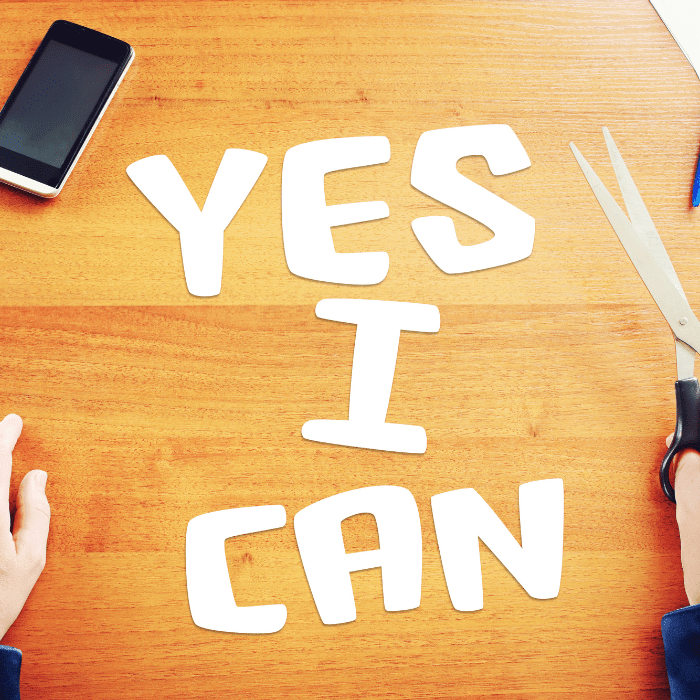Here’s a little transparency: Our website contains affiliate links. This means we may receive a small commission if you click and make a purchase. Don’t worry—there’s no extra cost to you. It’s a simple way you can support our mission to bring you quality content. Learn more at the Affiliate Disclosure page.

Mastering Self-Confidence: A Step-by-Step Guide to Unwavering Belief in Yourself
Self-confidence is the quiet power transforming how we see ourselves and interact with the world. It’s not about arrogance or thinking you’re the greatest thing since sliced bread; it’s about trusting your ability to face challenges head-on and navigate life with poise. Let’s explore practical strategies to build self-confidence beyond generic advice to provide actionable insights.
Understanding Self-Confidence: The Core of Belief
Self-confidence sets the stage for how we act, react, and succeed. At its essence, it is the belief in your ability to achieve goals, solve problems, and handle setbacks. You’re not born with it; it’s cultivated over time through experiences, reflection, and practice.
The Role of Psychology in Confidence
Self-confidence stems from the thoughts, experiences, and feedback we internalize. If you constantly hear negative messages, they can chip away at your belief in yourself. On the flip side, positive reinforcement and accomplishments bolster this belief.
Studies in psychology reveal that confidence is closely tied to self-efficacy—the understanding that you can influence outcomes. By fostering this mindset, you can develop confidence as a skill.
Spotting the Confidence Killers
Life throws curveballs that test even the strongest of us. Recognizing the sources of low confidence is the first step toward overcoming them.
The Usual Suspects:
- Failures: They often leave scars on your confidence. But failure is just feedback; it’s an opportunity to learn and improve.
- Negative Feedback: Words matter. Harsh criticism, especially from influential figures, can linger in your mind.
- Comparison Syndrome: Constantly measuring yourself against others diminishes your unique strengths.
- Perfectionism: The need to be flawless often leads to procrastination and self-doubt.
How to Tackle These Challenges
Start by reframing these obstacles. For instance, instead of fearing failure, consider it a necessary step to growth. Similarly, remind yourself that everyone’s journey is different, and comparison is a thief of joy.
The Power of Small Wins
Building confidence isn’t about achieving monumental feats overnight. It’s about taking small, consistent steps forward.
Keeping Promises to Yourself
Start small: commit to a daily walk, finish a book chapter, or set aside time for reflection. Each fulfilled promise reinforces trust in your capabilities.
Celebrate Every Victory
Don’t wait for the big wins. Celebrate the little ones—completing a workout, nailing a presentation, or even speaking up in a meeting. Each small triumph fuels your self-belief.
Harnessing Mindfulness to Boost Confidence
Mindfulness is a game-changer when taming negative self-talk and staying grounded. Focusing on the present moment creates space to challenge your doubts and reaffirm your abilities.

Simple Mindfulness Practices
- Breathing Exercises: Deep breathing can calm your mind and help you refocus when doubts creep in.
- Journaling: Write down your thoughts and feelings to gain clarity and perspective.
- Meditation: Even five minutes a day can significantly impact how you manage stress and negativity.
Why Mindfulness Works
When you’re mindful, you become aware of destructive thought patterns. Instead of spiraling into self-doubt, you can consciously replace negative thoughts with positive, constructive ones.
Rewriting Your Inner Narrative
The stories you tell yourself shape your reality. Negative affirmations like “I can’t” or “I’m not good enough“ can become self-fulfilling prophecies. Replacing these with positive affirmations can transform your mindset.
Unveiling the Confidence-Neuroplasticity Connection
One fascinating yet less discussed aspect of self-confidence is its relationship with neuroplasticity—the brain’s ability to adapt and rewire. Research shows that confidence-building exercises, like affirmations or mastering a new skill, create new neural pathways, strengthening the brain areas associated with self-belief.
The prefrontal cortex, responsible for decision-making and emotional regulation, becomes more active when you practice confidence-boosting behaviors. For example, visualizing success before attempting a challenge can prime your brain for better performance.
The Role of Emotional Regulation in Confidence
While many focus on positive affirmations, emotional regulation—managing and responding to emotions effectively—remains under-discussed in mainstream confidence-building strategies. A confident person isn’t devoid of fear or self-doubt; they regulate these emotions better.
- Techniques to Improve Emotional Regulation:
- Label Your Emotions: Instead of saying, “I’m scared,“ specify the feeling, like “I’m nervous about this presentation.“ This reduces its intensity.
- Reappraisal: Frame a challenge as an opportunity to grow rather than a threat to your abilities.
- Cold Showers and Stress Tolerance: This might sound unconventional, but brief exposure to stress, like cold showers, improves your body’s and mind’s ability to handle pressure, translating into a more composed demeanor in stressful situations.

Crafting Effective Affirmations
- Make them personal and specific: “I can deliver a great presentation.”
- Use present tense to reinforce immediacy: “I am confident and prepared.”
- Repeat them regularly until they become second nature.
The Science Behind Affirmations
Studies show positive affirmations can rewire neural pathways, making your brain more receptive to confidence-boosting behaviors.
Learning from Real-Life Role Models
Sometimes, seeing how others have done it is the best way to build confidence. Success stories can be both inspiring and educational.
What to Look for in Role Models
- Resilience: Seek stories of those who’ve bounced back from adversity.
- Authenticity: Learn from people who embrace and use their flaws as strengths.
- Action-Oriented Mindset: Confidence grows through doing, not just dreaming.
Applying Their Lessons to Your Journey
For instance, if someone you admire overcame a fear of public speaking, analyze their approach. Did they practice with a mentor? Did they start small? Adapt these strategies to your situation.
Cultivating a Supportive Environment
Your surroundings play a significant role in shaping your confidence. Toxic environments can drain your energy and belief in yourself, while positive ones can uplift and inspire.
Confidence and Body Language: A Bi-Directional Effect
It’s common to hear that confident body language—standing tall and maintaining eye contact—projects confidence. However, what’s less emphasized is the bidirectional relationship: adopting confident postures can make you feel more confident. This is backed by the “facial feedback hypothesis,“ which posits that physical expressions influence emotions.
Simply practicing an open posture for two minutes before a stressful situation can decrease cortisol (the stress hormone) levels and increase testosterone (the hormone associated with dominance and confidence).
Curate Your Circle
- Surround Yourself with Encouragers: Seek friends, family, and mentors who believe in you and push you to be your best.
- Distance from Negativity: Limit exposure to people who constantly criticize or doubt your abilities.
Leverage Resources
Books, podcasts, and workshops can provide practical tools for boosting confidence. Commit to lifelong learning and growth.
The Transformative Role of Habits
Building self-confidence is not a one-time act; it results from daily habits that compound over time. Think of it as planting seeds that grow into robust, unshakable trees.
Habits Worth Building
- Daily Gratitude Practice: Reflect on three things you’re proud of daily.
- Physical Activity: Exercise boosts endorphins and improves your sense of control and accomplishment.
- Continuous Learning: Mastering new skills builds confidence in your ability to tackle challenges.
Overcoming Self-Doubt
Everyone experiences self-doubt, even the most confident. The key is not to eliminate doubt but to manage it effectively.

Practical Strategies
- Question Your Doubts: Are they based on facts or assumptions?
- Focus on Past Successes: Remind yourself of challenges you’ve overcome before.
- Take Action Despite Fear: Confidence often comes after action, not before.
The Ripple Effect of Confidence
Once you start building self-confidence, its benefits extend beyond your personal life. It impacts your career, relationships, and ability to pursue your dreams.
How Confidence Shapes Success
Confident people are more likely to take risks, speak up for themselves, and seize opportunities. This ripple effect creates a cycle of growth and achievement.
Conclusion
Building unshakable self-confidence is a journey, not a destination. It’s about making small, consistent efforts to believe in yourself and rise above challenges. There are countless ways to strengthen your inner foundation, from mindfulness and affirmations to learning from role models and curating your environment. Remember, confidence isn’t about being perfect; it’s about showing up, flaws and all, and trusting that you can handle whatever comes your way.
FAQs
1. How long does it take to build self-confidence?
Building self-confidence is a gradual process that depends on your starting point and the effort you put in. Consistent practice and self-reflection can lead to noticeable changes in weeks or months.
2. Can self-confidence be lost?
Yes, life events like failures or criticism can temporarily shake your confidence. However, with resilience and the right tools, you can rebuild it.
3. Are affirmations effective for everyone?
Affirmations work best when they feel authentic. If they don’t resonate, try rephrasing them in a way that feels true to you.
4. Is it possible to be overconfident?
Overconfidence can lead to unrealistic expectations and risky decisions. Aim for a balanced confidence rooted in self-awareness.
5. Can therapy help with building confidence?
Absolutely. Therapists can help you identify and address underlying issues affecting your confidence, offering tailored strategies to improve it.
Get a VIP Access To Our Blog
Be the first to be notified when new content is released. Rest assured, we prioritize your Data Protection and Privacy and will never spam you.
Expand your consciousness and transform your life.
